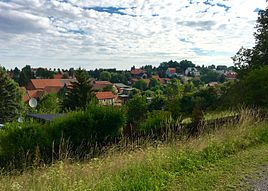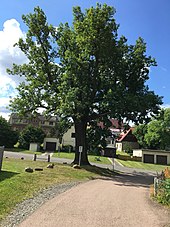Squint
|
Squint
Harzgerode city
|
|
|---|---|
| Coordinates: 51 ° 37 ′ 8 ″ N , 11 ° 13 ′ 8 ″ E | |
| Height : | 363 m |
| Area : | 19.77 km² |
| Residents : | 489 (Dec. 31, 2019) |
| Population density : | 25 inhabitants / km² |
| Incorporation : | August 1, 2009 |
| Postal code : | 06493 |
| Area code : | 039484 |
|
View from Eichberg to Hutberg with Schielo
|
|
Schielo is a district of the town of Harzgerode in the Harz district in Saxony-Anhalt .
history
The village was first mentioned in a document on August 21, 1430 and it still existed in 1488. Then Squinto fell in desolation and was only repopulated in 1546 during the recolonization that began in 1530. On the area of the Schulda desert and parts of the desert areas of Bauroda (Bugerode), Kitzerode (Kitzgerode) and Wernroth (Wernigerode), the princes of Anhalt had a farm ( domain ) with a sheep farm built, which was followed by the development of the village. In 1608 the Vorwerk cultivated around 15 Hufen and larger meadows. In the meantime, 41 families lived in the village, plus two housemates, pastors and schoolmasters as well as the workforce. After the resettlement, the place belonged to Anhalt , to the Harzgerode justice office. This fell to the Principality of Anhalt-Bernburg when the country was divided in 1603/06, belonged to the Principality of Anhalt-Harzgerode from 1635–1709 , then again to Anhalt-Bernburg and from 1863 to the Duchy of Anhalt .
The residents practiced agriculture and animal husbandry, another line of business was cutting wood. The effects of the Thirty Years War could be seen 20 years after its end through three still desolate farmsteads. Effects of the Seven Years' War and the Napoleon campaign , in particular through looting and the obligation to feed large contingents of troops from passing warriors ( 30,000 French warriors bivouacked in Güntersberge in 1806 ) have been handed down for neighboring towns, but not for Schielo himself.
In 1766 90% of the Schieloer joined the conspiracy in the Principality of Anhalt-Bernburg, which was mainly directed against the continued collection of contribution payments after the end of the Seven Years' War. In their own petition, they turned against the increase in the service fee, the loss of community wood, the doubling of the sheep population in the farm and the like. a. They took part in the Harzgeröder riot in March 1767 , paid for their work with two fatalities and up to four weeks' imprisonment for 22 men.
At the beginning of the 19th century the basket making trade flourished in the community . At that time, a significant part of the population secured their livelihood with the production of around 25,000 baskets annually. In 1833 an annual turnover of approx. 3500 thalers is reported in the basket-making workshop (in comparison: approx. 2000 thalers from woodcutting). The growing number of spruce trees displaced the hazel bushes that thrive in the undergrowth of deciduous forests and served as the raw material for the baskets. Various petitions and requests from the basket makers in the middle of the 19th century to curb spruce cultivation at the forestry office and the state parliament were all unsuccessful. More and more basket makers became farmers or worked for farmers in the area as "resin mowers". In the 1920s, basket making finally disappeared from Schielo. After the domain was dissolved in 1908, the basket-making village had become a farming village.
In October 1905, a tuberculosis sanatorium with 80 beds was opened a few kilometers outside the center of Schielo . This served as a military hospital in both world wars . By 1952 the capacity was expanded to 200 beds, and in 1975 a department for patients with cardiovascular diseases was added.
After the renovation in 1998, the clinic now serves as a dormitory for people with disabilities (mentally, mentally and through addiction). A significant proportion of the residents of Schielo (as of 2016: with 155 registered residents, almost 1/3) live in this facility.
In January 1944, the Jewish woman Philippine Mansfeld, born in Schielo, was born. Israel, deported to the Theresienstadt ghetto , where she was murdered on October 31, 1944.
From the beginning of 1958, the conversion of agriculture to the agricultural production cooperative "Type 1 Unity Schielo" caused considerable unrest in the village . Loudspeaker vans drove through the town calling out the names of farmers who refused to sign. 18 functionaries were entrusted with persuading the 21 Schielo farmers to join the LPG.
In 1976 the St. George's Church, built in 1558, was replaced by a simple new building.
In 1979 a late medieval coin depot was found in Schielo, which was established there around 1380.
On August 1, 2009, the community of Schielo merged with the towns of Güntersberge and Harzgerode and the communities of Dankerode , Königerode , Siptenfelde and Straßberg to form the new town of Harzgerode. As 150 years earlier, Schielo had 498 inhabitants at the end of 2016.
Origin of name
Schielo, still "Schuelo" in 1562, according to other documents "Schulde", "Suhle" or "Schulo", in dialect "Schiele", may have its origins in Slavic and means "place between the marsh meadows". Another explanation is the origin of the Middle High German word "Schielôh" with the meaning "Zaunpfahlhöölz" (from Middle High German "Schie" = fence post).
Population development
| year | Residents | Houses | households |
|---|---|---|---|
| 1562 | - | - | 37 |
| 1600 (approx.) | - | - | 42 |
| 1773 | - | - | 66 |
| 1795 | 426 | 78 | - |
| 1833 | 525 | 92 | - |
| 1865 | 496 | 108 | - |
| 2016 | 510 | - | - |
| 2019 | 489 | - | - |
politics
coat of arms
The coat of arms shows the linden tree, which was planted on the Hutberg in the middle of the village at the end of the Thirty Years War and is still a landmark and monument today. The linden tree has been featured in the commune's seal for decades. The basket stands for the importance of basket-making in the history of the place.
Blazon : "In silver on a green mountain, a green linden tree, the mountain covered with a braided silver basket."
The coat of arms was approved on March 13, 2009 by the district.
flag
The flag is white - green (1: 1) striped (longitudinal shape: stripes running vertically) and centered with the municipal coat of arms.
Memorials
Near the Ortlinde there is a memorial with the names of 58 people who died in the Schielo emergency hospital (actually tuberculosis sanatorium) and were buried on Hutberg during World War II. In the local cemetery there are two gravesites laid out in March 1945 for known Soviet prisoners of war or forced laborers . Near the church is the St. Peter's Oak , which was planted there on the occasion of the end of the wars with France in 1871.
traffic
Schielo is located off the main traffic arteries north of the federal highway 242 , which runs between Harzgerode and Klostermansfeld .
Two bus routes operated by the Harz Transport Authority are available as public transport , which connects the community with Harzgerode and stops in the center of the village.
Leisure and Tourism
In Schielo there are several providers of holiday apartments and holiday homes. The nature trail on the Eichenberg provides information about the local flora and fauna. In Schielo there is an opportunity for horse riding, in close proximity to fishing and bowling.
Sons and daughters of the place
- Karl Blossfeldt (1865–1932), photographer who was best known for his strictly formal plant photographs. In terms of photo art, he is considered a representative of the New Objectivity .
- Johann Ernst Sander (1718–1772), bailiff from Anhalt-Bernburg, tenant of the Osmarsleben manor, grandfather of Friedrich Ludwig Sander , great-grandfather of Enno Sander .
literature
- Memorandum for the 50th anniversary of the Schielo Sanatorium in the East Harz 1905–1955. 1955.
- Fritz Klocke : A stable house in Schielo. In: Fritz Klocke: Building, Living and Business in the Vor and Unterharz. 2001, ISBN 3-932863-70-4 .
- Ernst Kiehl: Schielo, a small village in the Lower Harz - its history and its poems . In: General Harz Mountain Calendar for 2007, 2006
- Karl-Heinz Börner : Harzgeröder Aufruhr 1767. In: Harzgeroder Hefte 5, 2011.
- Karl-Heinz Börner: The offices of Harzgerode and Güntersberge between the Reformation and the Thirty Years War . Harzgeroder Hefte 10, 2017 ISBN 978-3-942975-19-3
Others
The fantasy novel "The Key of Schielo" tells a witch story from the Harz region. In the book “Goethe” by Hans Gerhard Gräf there is a chapter “In Molmerschwende and Schielo - A travel adventure”. Graptolites were found in the quartz-containing slate soil of Schielo at the beginning of the 20th century .
See also
List of cultural monuments in Schielo.
Individual evidence
- ↑ Susanne Thon: More immigrants again . In: Mitteldeutsche Zeitung . Quedlinburger Harzbote. January 15, 2020, p. 9 .
- ^ Harzmuseum Wernigerode: Der Harz, Volumes 2–12, 1979, page 69
- ^ Journal of the Harz Association for History and Antiquity, Volume 8, 1875, page 220
- ↑ Journal of the resin vereins of History and Archeology, Eduard Jacobs: Archeology, Volumes 67-75, 1934, page 40
- ↑ Chronicle Schielo: "Fight against high forest and spruce forest."
- ↑ Chronicle Schielo: "Harzmower." Description of the way farm workers work in Schielo.
- ^ National Museums in Berlin: Research and Reports, Volumes 15-16, Akademie-Verlag 1973, page 222
- ↑ Metall und Erz, Volume 12, Gesellschaft Deutscher Metallhütten- and Miners , Metal and Ore, Society for Ore Mining, Metallurgy and Metallurgy, Society Metal and Ore, Section Metal Ore Mining, Association of Metallerzberg, Section Metal Producing Industry, 1915, page 128
- ↑ Our Harz: September 2013
- ^ Andreas Jüttemann: The Prussian Lung Sanatorium 1863-1934, Berlin 2015, page 165
- ↑ Research Bundesarchiv.de (accessed on July 8, 2016)
- ↑ Holocaust.cz (accessed July 7, 2016)
- ^ Archives Schielo: When the LPG began.
- ↑ Hans-Dieter Dannenberg: The denarii of Brandenburg's neighbors in the 13th and 14th centuries: Anhalt, Sachsen-Wittenberg with Brehna, Magdeburg: catalog of types, minting times, historical contexts, Numismatic Society in Berlin, 2000, page 79
- ↑ StBA: Area changes from January 2nd to December 31st, 2009
- ↑ Chronicle Schielo: "The old debt."
- ^ Gustav Hey, Karl Schulze: The settlements in Anhalt: localities and desolations with an explanation of their names, Verlag Waisenhaus, 1905, page 130
- ^ Chronicle Schielo: "Residents, Services and Development."
- ↑ a b Official Journal of the District No. 4/2009 page 21 ( Memento of the original from January 28, 2015 in the Internet Archive ) Info: The archive link was automatically inserted and not yet checked. Please check the original and archive link according to the instructions and then remove this notice.
- ↑ Mitteldeutsche Zeitung: Inauguration of the monument (accessed on July 9, 2016)
- ↑ Federal Agency for Civic Education: Memorials for the Victims of National Socialism Volume II, Bonn 1999, ISBN 3-89331-391-5 , page 584
- ↑ On July 4, 2016, the described grave sites could not be found on site despite searches and inquiries.
- ↑ Hans-Joachim Wilder: The key from Schielo, Prolibris Verlag, 2014, ISBN 978-3-95475-107-5
- ^ Hans Gerhard Graf: Goethe, BoD - Books on Demand, 2015, ISBN 978-3-8460-8239-3 , page 431ff
- ^ Geological Service Berlin, Preussische Geologische Landesanstalt, Germany. Reich Office for Soil Research, Geological State Institute Berlin: Abhandlungen, Germany. Reich Office for Soil Research, Akademie Verlag 1929,







